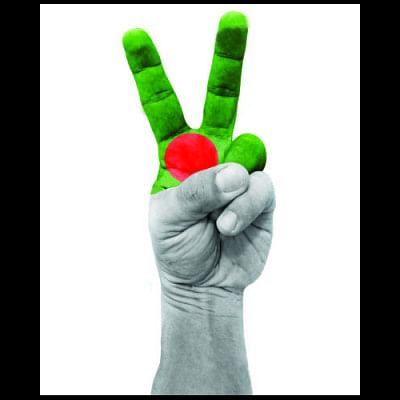Flags through the ages

In February 15 of 1969, the Pakistani army shot and killed Sergeant Zahurul Haq - one of the accused of the Agartala Conspiracy Case - in the army barracks. It became clear to the protesters that a war was looming.
Following the unjust killing of Sergeant Zahurul Haq, the first armed force was formed and consisted of many student leaders who were getting ready for the war of independence. It was named the 'February 15 Bahini.' They sat down in room #108 of Sergeant Zahurul Haq Hall (erstwhile Iqbal Hall) of the University of Dhaka to design a flag for the force.
With the help of February 15 Bahini and the painting of Shibnarayan Sharma, the proud red and green came into being with a golden map of Bangladesh (the then East Pakistan) in the heart of the red circle.
That was history in the making and independence was inevitable.
How did this one piece of coloured fabric come to mean so much to us? A look into the history of flags may give us some answers.
The ancestor of the modern flag goes back to the Iron Age. It is called a standard or a vexilloid, which is a metal or wooden pole with carvings on top. The word 'vexilloid' comes from the Latin word meaning 'guide.' Ancient groups of people would stick a metal pole to the ground marking their territory and would also identify themselves using the carvings on it.
The oldest example of a vexilloid is from 2400 BC. It was found in Shahdad, Iran and is now kept in the National Museum of Iran. The Shahdad Standard is a squared bronze piece, mounted on a 128-centimeter metal axle on which the flag can turn.
The carving on the Shahdad Standard is of a Shahbaz (royal falcon), a fabled bird and god of Iran. There is also an emblem on the flag depicting a rain goddess and an irrigation method of Shahdad. The first cloth flags are argued to have come from China some 5000 years ago following the development of sericulture. It made possible the production of light, large and colourful flags for using outdoors. They were used as a means of identification and signalling.
When warriors charged into battle in full armour, it was impossible to know who was an enemy and who was an ally. So, the Chinese warlocks would carry a flag into war, making it easy for the allies to protect them.
However, the disadvantages of a flag were far outnumbered by the advantages in conveying important messages. So the flags extended beyond military use in China and became common in temples and religious processions.

The Chinese fabric flags came to the Arab world, through their use in wars and then to Europe through the Mediterranean trade. The Romans used two kinds of flags, one with the image of the goddess of victory painted on it, and the other, the 'flammula', with red streamers attached to the spear. There was another flag called the 'labarum', the Christian version of the Roman flags, and it displayed the portrait of the Roman emperor and his family.
During the middle ages, the Arabs used different colours in the flags representing different dynasties. As one dynasty followed another, contrasting colours were used to mark their predecessors. The Arabian use of flags gave basis to the political identity of flags.
However, flags did not carry the sense of unity until the sixteenth century. Before, flags were limited to the use and representation of monarchs and battle troops. The common people, lacking a flag of their own, were somewhat presented by their church banners and guild flags. There was a sharp contrast between the flags of the noblemen and the people.
The noble flags were elaborately designed with emblems of armorial bearings and pictures of royalty while the common people had simpler bi-colour or tri-colour flags with the latter becoming the popular design for the modern flag.
Since flags of the common people were usually church banners, crosses became a common theme of many European flags including the English flag with the red cross of St. George and the French flag with the cross of St. Denis.
Our flag rose as we rose in triumph in 1971 and it is flying today as our symbol of honour and our beacon of hope.
Photo: Collected

 For all latest news, follow The Daily Star's Google News channel.
For all latest news, follow The Daily Star's Google News channel. 



Comments